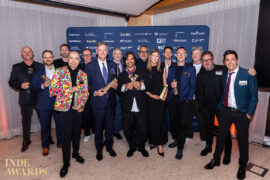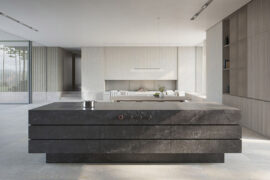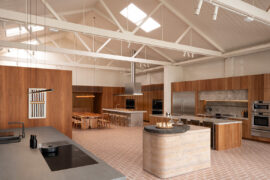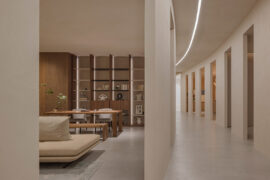In A+D we talk a big game about pushing boundaries. But, is there a ‘right’ way to push the boundary? What’s the secret to ongoing innovation?

Gaggenau had plenty of time to build up a very special expertise: With initial production of enamelled signs, they acquired valuable skills for the production of their enamelled ovens. Today, the typical blue Gaggenau enamel is a recognised brand and quality mark – and its recipe is a closely guarded trade secret.
Knowing when and where to push the boundaries is one of the hallmarks of successful design. In saying that, Gaggenau, now entering their 334th year and as the oldest kitchen appliances company in the world, might be considered to be somewhat of a gold-standard. However, what does pushing the boundary really mean, and how can it be understood across centuries of vast technological development? Can one push the boundary for the sake of boundary-pushing alone and still be considered constructive?
In truth, innovation for innovation’s sake is rarely conducive for success. The term ‘innovative’ wasn’t even given as a compliment up until 1939 or so. However, with our current understanding of the term, the best cases of innovation happen as a result of a shifting context such as new and evolving demands, or reconsidered values. Being able to recognise those changes and adapt is what defines successfully pushing boundaries.
Gaggenau was originally set up as an ironworks in a small German village of the same name in 1683, with founder Margrave Ludwig Wilhelm von Baden hoping to bring new economy to the area. Increased industrialisation throughout the 17th century saw the company expand in to the manufacture of agricultural machinery and tools before seguing into the cooking sector; the result of a burgeoning middle class requiring better cooking appliances in the domestic sphere and Gaggenau’s winning recipe for robust oven enamel.
This period saw Gaggenau become the worldwide leading luxury brand for home appliances as crowned/named by Wirtschaftswoche (the most renowned weekly business magazine in Germany).
How? By playing an integral role in rebuilding the new concept of ‘home’ and ‘domesticity’ in the 20th century. For, as Graham Crow says in The Post-war Development of the Modern Domestic Ideal “It is in this period that the modern domestic ideal of an affluent nuclear family living in a place of their own and enjoying the benefits of leisurely home life took shape.”
With Gaggenau being an early innovator in the electricity space, they were able to capitalise on this and play a significant role in what that new domestic ideal looked like. In 1948, at a time when coal and natural gas were in short supply, the company manufactured the first electric ovens with its Favorit and Futura models appearing on the market. Not long after, Georg von Blanquet took the helm at Gaggenau and the world’s first built-in appliances appeared – an innovation that propelled the brand further onto the global stage.
Today, as the world and its cuisines are drawn ever closer with faster travel and the Internet, Gaggenau continues to question how kitchen appliances can push onwards by developing appliances outside of their traditional contexts: now you can have the best in German engineering to create masterpieces of, say, Japanese gastronomy all in the comfort of your Australian home.
However, innovation is a narrow line to walk. Tread too far to either side and you risk alienating your base, or simply being forgotten. Despite that, Gaggenau has embraced the avant-garde as a design philosophy in order to lay a resilient path for ongoing innovation. In doing so, they have come to be the most widely distributed appliance brand in the world, pairing centuries of experience with a willingness to embrace technological changes as they have come (and even developing some of them on their own, such as in the case of their highly valued enamel recipe).
Their 400 Series built-in ovens expand on the developments made over the course of Gaggenau’s long history, namely their token blue enamel, which was initially developed in the 1880s, and the advent of built-in appliances in 1956. Paired with an understanding of the effect that the handle-free oven has upon the kitchen – increasingly being recognised as the centre of the home – and the consistent use of high-quality materials, the 400 Series has been built to stand the test of time in terms of both durability and design aesthetic.
INDESIGN is on instagram
Follow @indesignlive
A searchable and comprehensive guide for specifying leading products and their suppliers
Keep up to date with the latest and greatest from our industry BFF's!

Merging two hotel identities in one landmark development, Hotel Indigo and Holiday Inn Little Collins capture the spirit of Melbourne through Buchan’s narrative-driven design – elevated by GROHE’s signature craftsmanship.

For a closer look behind the creative process, watch this video interview with Sebastian Nash, where he explores the making of King Living’s textile range – from fibre choices to design intent.

With the opening of the 2026 INDE.Awards program, now is the time to assess your projects, ensure photography is at hand and begin your submissions.

Former INDE Luminary LeAmon joins the Design Institute of Australia (DIA) following more than a decade as the inaugural Curator of Contemporary Design and Architecture at the National Gallery of Victoria (NGV).

For those who appreciate form as much as function, Gaggenau’s latest induction innovation delivers sculpted precision and effortless flexibility, disappearing seamlessly into the surface when not in use.

The Fisher and Paykel Melbourne Experience Centre by Clare Cousins Architects with Fisher and Paykel Design and Alt Group has been awarded The Retail Space at the INDE.Awards 2025. As a winning project, it redefines the possibilities of retail architecture by creating an immersive, material rich environment shaped by place, culture and craft.
The internet never sleeps! Here's the stuff you might have missed

Merging two hotel identities in one landmark development, Hotel Indigo and Holiday Inn Little Collins capture the spirit of Melbourne through Buchan’s narrative-driven design – elevated by GROHE’s signature craftsmanship.

The Simple Living Passage marks the final project in the Simple World series by Jenchieh Hung + Kulthida Songkittipakdee of HAS design and research, transforming a retail walkway in Hefei into a reflective public space shaped by timber and movement.